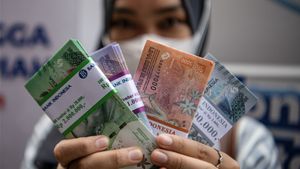JAKARTA - Bank Indonesia (BI) reported that Indonesia's external debt (ULN) in November 2021 decreased. It was stated that Indonesia's external debt position at the end of November 2021 was recorded at US$416.4 billion. The book decreased compared to the position in October 2021 which amounted to US$422.3 billion.
"This development was caused by a decline in the position of public sector external debt, namely the government and the central bank and the private sector," said Head of the BI Communications Department Erwin Haryono in a statement, Monday, January 17.
According to Erwin, on an annual basis, external debt in November 2021 grew at a low 0.1 percent (year-on-year/yoy), down from the previous month's external debt growth of 2.2 percent yoy.
In detail, the government's external debt position in November 2021 was US$202.2 billion, lower than the previous month's position of US$204.9 billion.
"The decline in government external debt was mainly due to the adjustment of foreign capital flows in the Government Securities (SBN) market in line with global sentiment that again pushed the trend of increasing US Treasury yields after the Federal Open Market Committee (FOMC) meeting," he said.
Erwin emphasized that the government is committed to maintaining credibility by fulfilling the obligation to pay principal and interest on debt in a timely manner, as well as managing external debt in a prudent, credible and accountable manner.
Meanwhile, the position of private external debt was recorded at US$ 205.2 billion in November 2021, down from US$ 208.3 billion in October 2021.
On an annual basis, private external debt contracted by 2.0 percent yoy in November 2021, deeper than the contraction of 1.0 percent yoy in the previous period.
"This development was caused by the contraction of external debt of financial institutions and non-financial corporations by 5.4 percent yoy and 1.0 percent yoy, respectively, in line with the repayment of external debt maturing during the November 2021 period," Erwin said.
By sector, the largest private external debt comes from several sectors, such as financial services and insurance, the electricity, gas, steam/hot water and cold air supply sector, and the manufacturing sector. This external debt remains dominated by the long term with a share of 77.7 percent.
Meanwhile, the ratio of Indonesia's external debt to Gross Domestic Product (GDP) is claimed by BI to be maintained in the range of 35.5 percent, a decrease compared to the ratio in the previous month of 36.1 percent.
In addition, the structure of Indonesia's external debt remains healthy, which is dominated by long-term external debt with a share of 89.0 percent of the total.
"The role of external debt will also continue to be optimized in supporting development financing and encouraging national economic recovery, by minimizing risks that can affect economic stability," concluded Erwin.
The English, Chinese, Japanese, Arabic, and French versions are automatically generated by the AI. So there may still be inaccuracies in translating, please always see Indonesian as our main language. (system supported by DigitalSiber.id)









